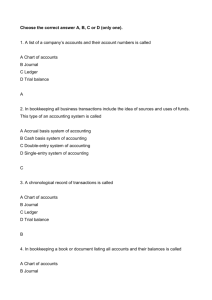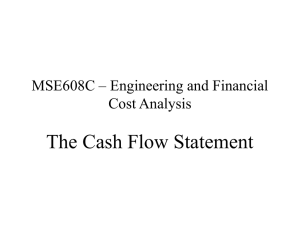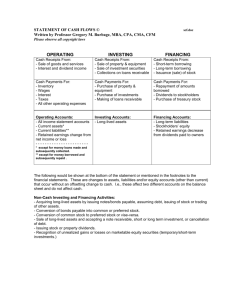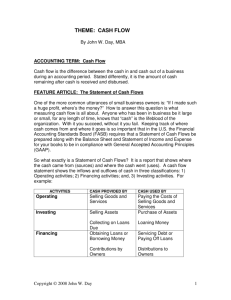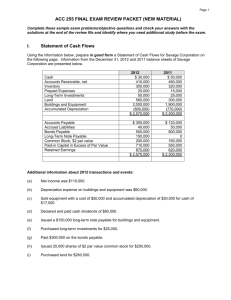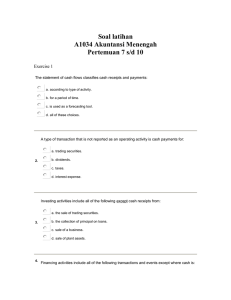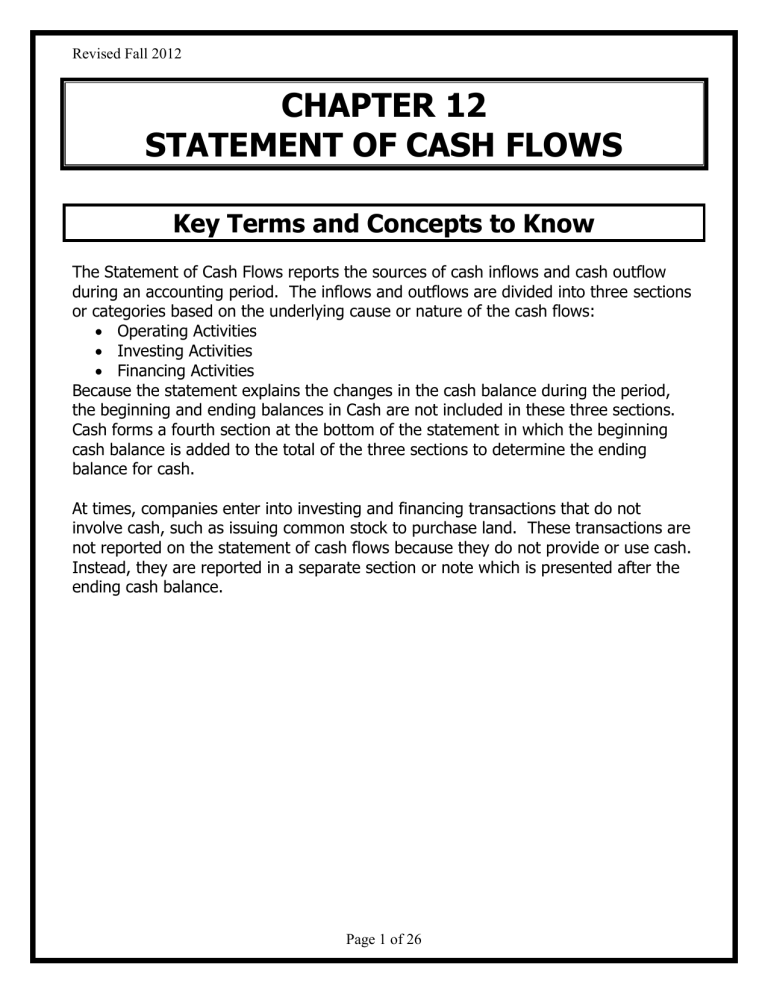
Revised Fall 2012 CHAPTER 12 STATEMENT OF CASH FLOWS Key Terms and Concepts to Know The Statement of Cash Flows reports the sources of cash inflows and cash outflow during an accounting period. The inflows and outflows are divided into three sections or categories based on the underlying cause or nature of the cash flows: Operating Activities Investing Activities Financing Activities Because the statement explains the changes in the cash balance during the period, the beginning and ending balances in Cash are not included in these three sections. Cash forms a fourth section at the bottom of the statement in which the beginning cash balance is added to the total of the three sections to determine the ending balance for cash. At times, companies enter into investing and financing transactions that do not involve cash, such as issuing common stock to purchase land. These transactions are not reported on the statement of cash flows because they do not provide or use cash. Instead, they are reported in a separate section or note which is presented after the ending cash balance. Page 1 of 26 Revised Fall 2012 Key Topics to Know The statement of cash flows explains the changes in the balance sheet during an accounting period from the perspective of how these changes affect cash. As noted above, the cash inflows and outflows are divided into three sections plus a cash section based on the balance sheet accounts underlying the cause or nature of the cash flows. Investing and financing activities that do not involve cash are presented in a separate schedule. Cash Flow Statement Section Balance Sheet Accounts Operating Activities Net Income = revenue – expenses Current assets excluding cash Current liabilities excluding dividends payable and short-term notes payable Investing Activities Non-current assets Financing Activities Long-term liabilities Short-term notes payable Capital stock and treasury stock Dividends declared and dividends payable Cash Cash Non-cash Investing and Financing Activities Changes in long-term liabilities, shortterm notes payable, capital stock and treasury stock that do not involve cash Practice Problem #1 Identify which section of the statement of cash flows each of the following events would appear in (operating, investing and financing or in a separate schedule): a) b) c) d) e) f) g) h) i) j) Purchased a Patent Sold Treasury stock Net Income Sold long-term investments Purchased a building Issued bonds. Paid dividends Recorded depreciation expense for the year Issued common stock to retire a mortgage Purchased treasury stock Page 2 of 26 Revised Fall 2012 Operating Activities Operating Activities include the events and transactions that determine day-today operating activities. These events and transactions include net income and the changes in the current asset and current liability accounts related to net income. Those transactions and events that do not provide or use cash are excluded from determining cash flows from operating activities. For example, sales on account are used to determine net income, but to the extent that these sales remain uncollected at the end of the period, the increase in accounts receivable is not a cash flow and must be deducted when converting net income into cash flow from operating activities. Examples of non-cash transactions include depreciation, depletion and amortization expense and gains and losses from the sale of plant assets and the retirement of bonds. There are two methods of preparing the operating activities section: Indirect Method and Direct Method. Both methods calculate the same total of cash flows from operating activities, although the methodologies are considerably different. Indirect Method The indirect method starts with net income and adjusts it for non-cash transactions and other cash used by or provided by normal daily activities. Net Income Add: Noncash expenses (i.e., depreciation and amortization) Losses on sales or retirements Decreases in Current Assets Increases in Current Liabilities related to operations* Deduct: Increases in Current Assets Decreases in Current Liabilities related to operations* Gains on sales or retirements =Net Cash Flows from Operating Activities *Note that changes in non-operating current liabilities are included elsewhere on the statement. For example, changes in dividends payable are combined the dividends declared to calculate dividends paid in the financing section. Page 3 of 26 Revised Fall 2012 Example #1 Given the following information and using the indirect method prepare the Cash Flows from Operating Activities section of the statement of cash flows. Cash Accounts receivable (net) Inventories Prepaid expenses Accounts payable (creditors) Salaries Payable End of Year $ 23,500 84,500 100,200 4,970 71,400 5,320 Beginning of Year $ 37,400 80,350 94,300 5,300 68,900 6,450 Change (13,900) 4,150 5,900 (330) 2,500 (1,130) Net Income reported on the income statement for the current year was $134,800. Depreciation expense recorded on buildings and equipment was $27,400 for the year. Solution #1 Net Income Add: Decrease in prepaid expenses Increase in Accounts Payable Depreciation Expense Deduct: Increase in Accounts Receivable Increase in Inventories Decrease in Salaries Payable Net Cash Flows from Operating Activities Page 4 of 26 $ 330 2,500 27,400 $ 4,150 5,900 1,130 $134,800 30,230 165,030 11,180 $153,850 Revised Fall 2012 Practice Problem #2 Given the following information and using the indirect method prepare the Cash Flows from Operating Activities section of the statement of cash flows. Cash Accounts Receivable Merchandise Inventory Prepaid Expenses Accounts Payable (creditors) Wages Payable End of Year $345,000 554,300 693,000 27,000 510,000 39,500 Beginning of Year $386,000 567,800 672,400 24,000 527,400 36,000 The net income reported on the income statement for the current year was $465,000, which included a gain on sale of investments of $3,000. Depreciation expense recorded on store equipment for the year amounted to $99,800. Direct Method The direct method starts with the entire accrual-basis income statement (not just net income) and converts it line-by-line to the cash basis. The resulting cash inflows and outflows are the cash flows used by or provided by normal daily activities. For example, accrual-basis sales are converted to cash collected from customers by adding the decrease or deducting the increase in trade accounts receivable. The direct method is preferred by the FASB as it provides more useful information the users of the financial statements. The FASB requires that, if the direct method is used, that a reconciliation of net income to net cash provided or used by operating activities be provided in the footnotes or as part of the statement. This reconciliation frequently looks quite similar to the cash flow from operating activities section prepared using the indirect method. Page 5 of 26 Revised Fall 2012 The operating activities section prepared using the direct method would appear as follows: Cash received from customers: o Sales (+decrease in A/R OR -increase in A/R) Less: payments to creditors and for expenses o Cost of Merchandise Sold +increase in inventories OR -decrease in inventories +decrease in A/P OR -increase in A/P o Operating Expenses +decrease in accrued expenses OR -increase in accrued expenses o Interest Expense +decrease in interest payable OR -increase in interest payable o Income Tax Expense +decrease in income tax payable OR -increase in income tax payable =Net Cash Flows from Operating Activities Investing Activities Investing Activities include events and transactions that affect long-term assets. For example, the journal entry to record the sale of land with a cost of $100,000 for $120,000 would be: Cash 120,000 Land Gain on sale 100,000 20,000 The effect of this transaction is to reduce long-term assets by $100,000. On the statement of cash flows, the cash proceeds are reported as an inflow in the investing activities section and the gain is deducted from net income in the operating activities section as noted above. If equipment is purchased for $75,000, the journal entry would be: Equipment Cash 75,000 75,000 The $75,000 would be reported as a use of cash in the investing section. Page 6 of 26 Revised Fall 2012 The Investing Activities section would appear as follows: Cash inflows from: Sale of Long-term Assets o Property, Plant or Equipment o Intangible assets o Investments Less: Cash outflows from: Purchase of Long-term Assets o Property, Plant or Equipment o Intangible assets o Investments =Net Cash Flows from Investing Activities Example #2 Given the following selected information, determine the net cash flows from investing activities and the net cash flows from financing activities: a) Net income was $189,500 for the period. b) Purchased 10,000 shares of common stock at $15 per share for the treasury. c) Sold equipment with a carrying value of $32,500 at a gain of $6,000. d) Purchased land and a building worth $450,000 by signing a ten-year note payable. e) Issued $1,000,000 in bonds at par. f) The beginning and ending retained earnings account balances were $418,000 and $534,000, respectively. There were no prior period adjustments during the period. g) Wrote a check for $648,000 for the purchase of machinery. h) Sold long-term investments in marketable securities with a $50,000 carrying value, at a loss of $17,500. i) Cash dividends were declared and paid during the period. Solution #2 Investing Activities Cash received from sale of equipment $32,000 – 6,000 = Cash received from sale of investments $50,000 – 17,500 = Cash paid for machinery Net cash flows from investing activities Page 7 of 26 $38,500 32,500 (648,000) ($577,000) Revised Fall 2012 Financing Activities Financing Activities include events and transactions that affect long-term liabilities and equity other than net income. For example, the journal entry to record the issuance of bonds with a face value of $100,000 would be: Cash 100,000 Bonds payable 100,000 The effect of this transaction is to increase long-term liabilities by $100,000. On the statement of cash flows, the cash proceeds are reported as an inflow in the financing activities section. If the bonds are subsequently retired at 101, the journal entry would be Loss on retirement Bonds payable Cash 1,000 100,000 101,000 The effect of this transaction is to reduce long-term liabilities by $100,000. On the statement of cash flows, the cash spent is reported as an outflow in the financing activities section and the loss is added to net income in the operating activities section as noted above. Dividends paid are also included in the financing activities section. Dividends paid are not part of the operating activities section because dividends do not appear in the income statement. They are reported in the financing activities section because they relate to the equity section of the balance sheet and cash flows from changes in equity are reported in this section. Whenever the beginning balance does not equal the ending balance for dividends payable, the dividends paid will have to be calculated using the following formula: beginning balance + dividends declared - ending balance = dividends paid If the beginning balance equals the ending balance for dividends payable or there are no beginning and ending balances for dividends payable, then the dividends paid equals the dividends declared. Page 8 of 26 Revised Fall 2012 The Investing Activities section would appear as follows: Cash inflows from: Issuing debt or equity securities o Issuing bonds o Issuing Stocks (Common and Preferred) o Reissuing Treasury Stocks o Issuing other long-term debts (mortgage payable, notes payable) Less: Cash outflows from: Retiring debts, repurchasing equity securities and paying dividends o Payments to retire bonds o Payments to retire other long-term debts o Payments for Dividends o Payments to purchase Treasury Stock =Net Cash Flows from Financing Activities Again, Non-cash Financing and Investing Activities, such as issuing stock to retire bonds, are reported in a separate schedule that appears after the bottom of the Statement of Cash Flows. Example #3 Given the following selected information, determine the net cash flows from investing activities and the net cash flows from financing activities: a) Net income was $189,500 for the period. b) Purchased 10,000 shares of common stock at $15 per share for the treasury. c) Sold equipment with a carrying value of $32,500 at a gain of $6,000. d) Purchased land and a building worth $450,000 by signing a ten-year note payable. e) Issued $1,000,000 in bonds at par. f) The beginning and ending retained earnings account balances were $418,000 and $534,000, respectively. There were no prior period adjustments during the period. g) Wrote a check for $648,000 for the purchase of machinery. h) Sold long-term investments in marketable securities with a $50,000 carrying value, at a loss of $17,500. i) Cash dividends were declared and paid during the period. Page 9 of 26 Revised Fall 2012 Solution #3 Financing Activities Cash paid to purchase treasury stock 10,000 shares x $15 = Cash received from sale of bonds Cash paid for dividends $418,000 + 189,500 - 534,000 = Net cash flows from financing activities ($150,000) 1,000,000 (73,500) $776,500 Practice Problem #3 For each of the following situations indicate the items to be reported on the statement of cash flows, the section of the statement in which the item would appear and the amount. a) b) c) d) e) f) g) The board of directors declared cash dividends totaling $240,000 during the current year. The comparative balance sheet indicates dividends payable of $50,000 at the beginning of the year and $60,000 at the end of the year. Office equipment, which had cost $245,000 and on which accumulated depreciation totaled $95,000 on the date of sale, was sold for $130,000 during the year. Delivery equipment, which had cost $39,000 and on which accumulated depreciation totaled $23,000 on the date of sale, was sold for $20,000 during the year. The company issued 5,000 shares of $10 par Common Stock for $50 per share. The company purchased land with a mortgage note payable. Depreciation expense reported on the income statement was $55,000. Bonds Payable of $60,000 were retired. Cash After the Operating, Investing and Financing sections have been completed, the Cash account must be analyzed. The sum of the net cash flows from each of the three activities sections represents the change in cash, i.e., the net cash flows for the period. Adding the change in cash to the beginning cash balance from the balance sheet must equal the ending cash balance on the balance sheet. Page 10 of 26 Revised Fall 2012 Practice Problem #4 Charlotte Company's net income last year was $91,000. Changes in the company's balance sheet accounts for the year appear below: Cash Accounts receivable Inventory Prepaid expenses Long-term investments Property, plant and equipment Accumulated depreciation ($13,000) 16,000 21,000 (8,000) 30,000 60,000 36,000 Accounts payable Accrued expenses Income taxes payable Bonds payable Common stock Retained earnings (21,000) 14,000 42,000 (50,000 20,000 65,000 The company did not dispose of any property, plant, and equipment, sell any longterm investments, issue any bonds payable, or repurchase any of its own common stock during the year. The company declared and paid a cash dividend. The beginning and ending cash balances were $20,000 and $7,000, respectively. Required: Prepare a statement of cash flows using the indirect method. Page 11 of 26 Revised Fall 2012 Practice Problem #5: Arcade Corporation's balance sheet and income statement appear below: Income Statement Sales Cost of goods sold Gross margin Selling and administrative expenses Income before income taxes Income tax expense Net income $723 453 270 163 107 32 $75 Balance Sheet Cash Accounts receivable Inventories Plant and equipment less: accumulated depreciation Total Assets Accounts payable Bonds payable Common stock Retained earnings Total liabilities and equity Ending Balance $42 77 54 581 (318) $436 Beginning Balance $36 80 58 480 (294) $360 $23 293 61 59 $436 $28 270 60 2 $360 The company did not dispose of any property, plant, and equipment, retire any bonds payable, or repurchase any of its own common stock during the year. The company declared and paid a cash dividend. Required: Prepare a statement of cash flows using the indirect method. Page 12 of 26 Revised Fall 2012 Sample True / False Questions 1. The statement of cash flows explains how the cash balance changed during a particular period of time. True False 2. Payment of interest on a note payable is a cash flow from a financing activity. True False 3. Collection of principal on a note receivable is a cash flow from financing activities. True False 4. The difference between the indirect and direct methods of cash flow determination only affects the determination of investing activities cash flows. True False 5. Cash collected from customers is a cash flow from operating activities, which is calculated using the indirect method in preparing the statement of cash flows. True False 6. Cash flows associated with property, plant, and equipment acquisition and disposition are reported as cash flows from investing activities. True False Page 13 of 26 Revised Fall 2012 7. Cash flows associated with issuance and retirement of long-term debt and equity are reported as cash flows from investing activities. True False 8. Under the indirect method, an increase in accounts receivable during the year will be added to net income. True False 9. Under the indirect method, depreciation expense is added to net income, because it decreases net income but doesn't consume a cash flow. True False 10. Under the indirect method, a decrease in inventory is deducted from net income, because inventory purchases are less than cost of goods sold. True False 11. Under the indirect method, an increase in prepaid expenses is deducted from net income, because the cash prepayments exceed the related expenses. True False 12. When a company purchases equipment using common stock, the equipment purchase is reported as a financing activity. True False 13. When a company sells equipment for cash at a loss, cash flows from investing activities decreases. True False 14. Amortization of a patent reduces cash flows from investing activities. True False 15. When a company both borrows $150 million during the year and repays $120 million of notes, the company can disclose the $30 million net amount as excess of borrowings over repayments in the financing activities section. True False 16. Cash flows from financing activities include those cash flows with respect to issuing and retiring long-term debt and equity. True False 17. Cash flows from financing activities include those cash flows with respect to paying previously declared dividends. True False Page 14 of 26 Revised Fall 2012 18. Wish Corporation acquired a computer for $15,000 and paid for it in full by issuing 1,000 shares of its own common stock, par $10 (current market price $15 share). This transaction should not be reported on the statement of cash flows because cash was neither paid out nor received. True False 19. Most companies use the direct method for disclosing their cash flows from operating activities rather than the indirect method. True False 20. When accrued liabilities increase from the beginning to the end of the year, it means accrued expenses were greater than cash payment of such expenses so the increase would be added to net income to convert to cash flow from operating activities under the indirect method. True False Page 15 of 26 Revised Fall 2012 SAMPLE MULTIPLE CHOICE QUESTIONS 1. If a loss of $15,000 is incurred in selling (for cash) office equipment having a book value of $50,000 the total amount reported in the cash flows from investing activities section of the statement of cash flows is: a) $22,000 b) $78,000 c) $35,000 d) $15,000 2. Land costing $78,000 was sold for $100,000 cash. The gain on the sale was reported on the income statement as other income. On the statement of cash flows, what amount should be reported as an investing activity from the sale of the land? a) $22,000 b) $78,000 c) $100,000 d) $178,000 3. On the statement of cash flows, the cash flows from operating activities section would include: a) Receipts from interest on short-term notes receivable b) Receipts from the issuance of capital stock c) Payments for the acquisition of investments d) Payments for cash dividends 4. A business issues 20-year bonds payable in exchange for preferred stock. This transaction would be reported on the statement of cash flows in: a) The cash flows from investing activities section b) The cash flows from operating activities section c) The cash flows from financing activities section d) A separate schedule 5. A statement of cash flows would not disclose the effects of which of the following transactions? a) Purchase of treasury stock b) Bonds payable exchanged for capital stock c) Stock dividends declared d) Capital stock issued to acquire plant assets Page 16 of 26 Revised Fall 2012 6. Depreciation on factory equipment would be reported in the statement of cash flows prepared by the indirect method in: a) The cash flows from financing activities section b) The cash flows from investing activities section c) The cash flows from operating activities section d) A separate schedule 7. Which of the following would be classified as an operating activity? a) Payment of a cash dividend b) Sale of equipment c) Making a loan to another entity d) Payment of interest 8. Which of the following is not an operating activity? a) Payment of taxes b) Dividends received c) Payment of a cash dividend d) Payment to suppliers 9. The change in accumulated depreciation on factory equipment would be reported in the statement of cash flows prepared by the indirect method in: a) The cash flows from financing activities section b) The cash flows from investing activities section c) The cash flows from operating activities section d) Not reported as it is not a cash flow 10. The indirect method of preparing the statement of cash flows begins with a) Collections from customers b) Cash sales c) Net income d) Beginning Cash Balance 11. Under the indirect method of preparing the statement of cash flows, an increase in accounts receivable is: a) Added to net sales b) Deducted from net sales c) Added to net income d) Deducted from net income Page 17 of 26 Revised Fall 2012 12. Under the indirect method of preparing the statement of cash flows, which of the following is added to net income in the operating activities section? a) Gain on sale of equipment b) Depreciation expense c) Increase in accounts receivable d) Decrease in accounts payable 13. Under the indirect method of preparing the statement of cash flows, which of the following is deducted from net income in the operating activities section? a) Gain on sale of land b) Amortization expense c) Decrease in inventory d) Increase in wages payable 14. Assume a company sold a piece of equipment for $3,000. The original cost was $15,000 and the accumulated depreciation prior to the sale was $10,000. What amount, if any, would appear in the operating activities section of the statement of cash flows using the indirect method? a) $0 b) $2,000 c) $3,000 d) $15,000 15. Which of the following would be classified as a financing activity? a) Purchase of treasury stock b) Receipt of dividends c) Sale of an investment in bonds d) Purchase of a Patent 16. Bonds with a face value of $800,000 and interest rate of 8% are issued at 105 on January 2, 2002. The bonds pay interest semiannually on January 1 and July 1 and mature in 5 years. What is the total interest expense in 2002? a) $32,000 b) $56,000 c) $64,000 d) $72,000 Page 18 of 26 Revised Fall 2012 17. Samson Enterprises issued a ten-year, $20 million bond with a 10% interest rate for $19,500,000. The entry to record the bond issuance would have what effect on the financial statements? a) Increase assets b) Increase liabilities c) Increase equity d) a) and b) 18. Megginson, Inc. issued a five-year corporate bond of $300,000 with a 5% interest rate for $330,000. What effect would the bond issuance have on Megginson, Inc.'s accounting equation? a) Increase assets and liabilities b) Increase and decrease assets c) Increase assets and equity d) Increase and decrease liabilities 19. Which of the following would be classified as an investing activity? a) Purchasing an investment in bonds b) Payment of a dividend c) Issuing Common Stock d) Payment of interest 20. According to the comparative balance sheet, the balance of the Dividends Payable account at the beginning and end of the year was $54,000 and $52,500 respectively. The Retained Earnings Statement indicates that $80,000 in dividends was declared during the year. What amount of dividends was paid out during the year? a) $80,000 b) $54,000 c) $78,500 d) $81,500 Page 19 of 26 Revised Fall 2012 21. Given the following information and using the indirect method, calculate the cash flows from operating activities. End of Beginning Year of Year Cash $ 38,500 $ 44,200 Accounts receivable (net) 79,200 68,800 Inventories 90,700 81,100 Prepaid expenses 4,500 6,500 Accounts payable 65,000 72,800 Salaries Payable 5,900 5,400 Net Income reported on the Income Statement for the current year was $115,000, which included a loss on sale of land of $8,000. Depreciation recorded on office equipment for the year amounted to $48,000. a) $129,700 b) $137,700 c) $144,700 d) $145,700 22. A corporation issued $2,000,000 of 20-year bonds for cash at 108. How would this transaction be reported in the statement of cash flows? a) $2,000,000 inflow in cash flows from financing activities b) $2,000,000 inflow in cash flows from investing activities c) $2,160,000 inflow in cash flows from financing activities d) $2,160,000 inflow in cash flows from investing activities Page 20 of 26 Revised Fall 2012 Solutions to Practice Problems Practice Problem #1 a) b) c) d) e) f) g) h) i) j) Investing Financing Operating Investing Investing Financing Financing Operating Separate Schedule Financing Practice Problem #2 Net Income Add: Depreciation Expense Decrease in accounts receivable Increase in wages payable Deduct: Gain on sale of investments Increase in Inventories Increase in prepaid expenses Decrease in Accounts Payable Net Cash Flows from Operating Activities Page 21 of 26 $99,800 13,500 3,500 $3,000 20,600 3,000 17,400 $465,000 116,800 581,800 11,180 $537,800 Revised Fall 2012 Practice Problem #3 a) b) c) d) e) f) g) Dividends Payable 50,000 X 240,000 60,000 50,000 + 240,000 – X = 60,000 X = 230,000 dividends paid in Financing section Investing Inflow of $130,000 Book Value: 245,000 – 95,000 = $150,000 Loss of $20,000 is reported in the Operating Activity Section and is added back to net income Investing Inflow of $20,000 Book Value: 39,000 – 23,000 = $16,000 Gain of $4,000 is reported in the Operating Activity Section and is deducted from net income Financing Inflow of $250,000 Separate Schedule $55,000 is reported in the Operating Activity section and is added back to net income Financing Outflow of $60,000 Page 22 of 26 Revised Fall 2012 Practice Problem #4 Operating Activities: Net income Adjustments for non-cash effects: Depreciation expense Adjustments for changes in current assets and liabilities: Increase in accounts receivable Increase in inventories Decrease in prepaid expenses Decrease in accounts payable Increase in accrued liabilities Increase in income taxes payable Net cash flows from operating activities Investing Activities: Purchase of long-term investments Purchase of property, plant and equipment Net cash flows from investing activities Financing Activities: Retirement of bonds payable Cash dividends paid Issuance of common stock Net cash flows from financing activities Net Change in Cash Beginning cash balance Ending cash balance Page 23 of 26 $91,500 36,000 (16,000) (21,000) 8,000 (21,000) 14,000 42,000 133,000 (30,000) (60,000) (90,000) ($50,000) (26,000) 20,000 (56,000) $(13,000) 20,000 $7,000 Revised Fall 2012 Practice Problem #5 Operating Activities: Net income Adjustments for non-cash effects: Depreciation expense Adjustments for changes in current assets and liabilities: Decrease in accounts receivable Decrease in inventories Decrease in accounts payable Net cash flows from operating activities Investing Activities: Purchase of property, plant and equipment Net cash flows from investing activities Financing Activities: Cash dividends paid Issuance of bonds Issuance of common stock Net cash flows from financing activities Net Change in Cash Beginning cash balance Ending cash balance Page 24 of 26 $75 $24 3 4 (5) 2 101 (101) (101) (18) 23 1 6 6 36 $42 Revised Fall 2012 Solutions to True / False Questions 1. 2. 3. 4. 5. 6. 7. 8. 9. 10. 11. 12. 13. 14. 15. 16. 17. 18. 19. 20. True False - Interest payments are operating cash flows. False - Cash flows associated with lending activities are investing cash flows. False - The direct and indirect methods are options with respect to determining operations cash flows. False - The direct method calculates cash collected from customers. True False - Cash flows associated with issuance and retirement of long-term debt and equity are reported as cash flows from financing activities. False - Under the indirect method, an increase in accounts receivable during the year will be deducted from net income, because sales were greater than cash collections. True False - A decrease in inventory is added to net income, because inventory purchases are less than cost of goods sold. True False - Purchasing equipment using common stock doesn't involve a cash flow and is therefore not reported within the investing or financing section of the cash flow statement. False - Investing cash flows increase by the selling price of the equipment. False - Patent amortization is a noncash expense and therefore doesn't affect cash flows. False - Borrowing related cash inflows and outflows should be separately reported and not netted. True True False - Noncash investing and financing activities are reported as a supplement to the statement of cash flows. False - Most companies use the indirect method. True Page 25 of 26 Revised Fall 2012 Solutions to Multiple Choice Questions 1. 2. 3. 4. 5. 6. 7. 8. 9. 10. 11. 12. 13. 14. 15. 16. 17. 18. 19. 20. 21. 22. C C A D C C D C D C D B A B A B D A A D D C Page 26 of 26
